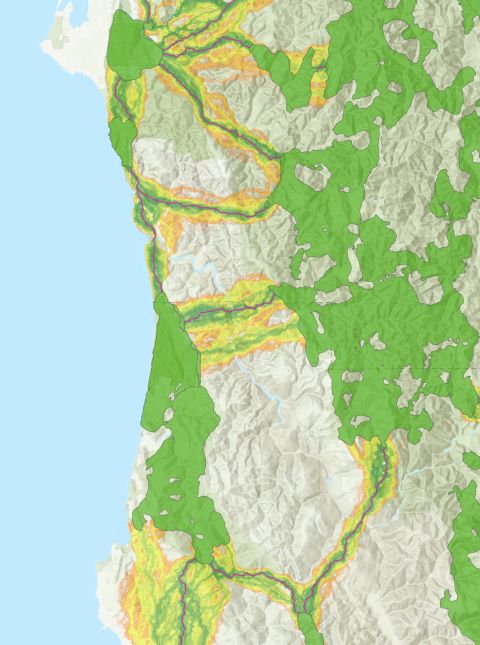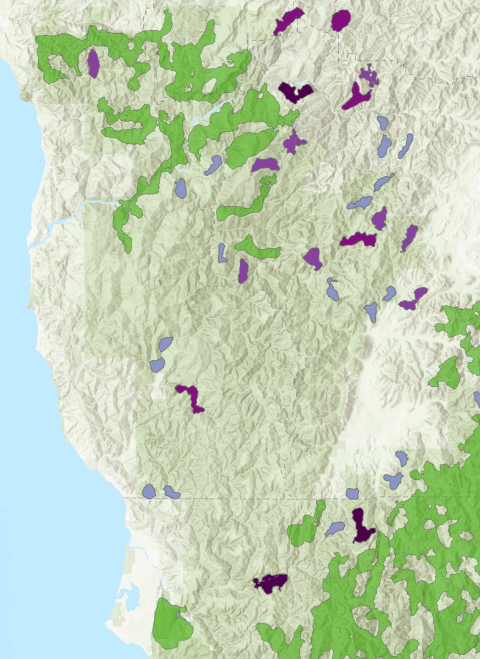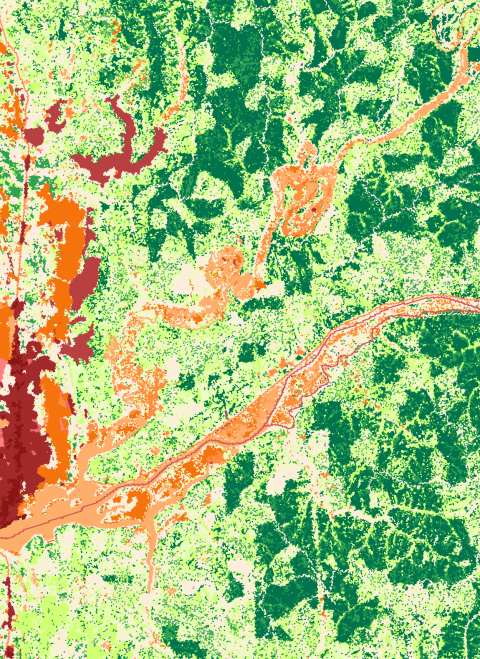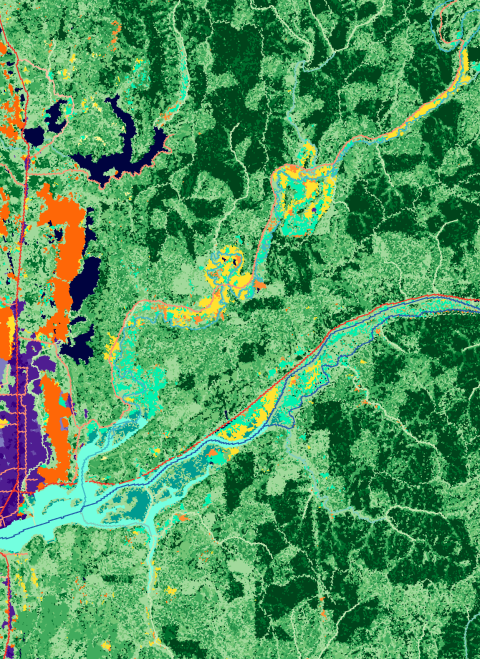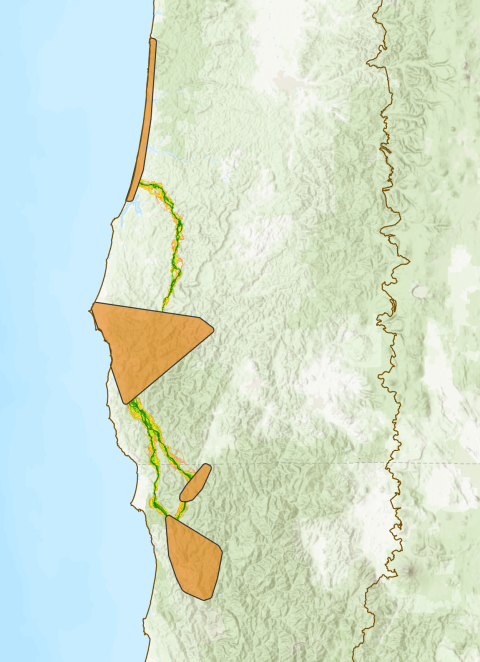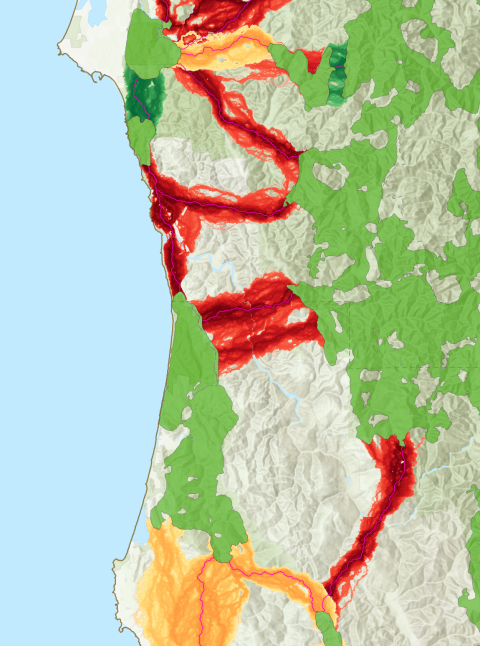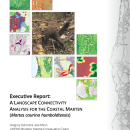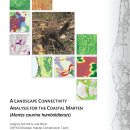States
California, Oregon, WashingtonEcosystem
Coastal, ForestThe coastal marten (also known as Humboldt marten) is a rare, medium-sized carnivore that is endemic to northwestern California and western Oregon. A subspecies of the Pacific marten, they are a member of the Family Mustelidae, which also includes the weasels, wolverine, fisher, badgers, skunks, and otters, among others. In 2018, it was proposed for listing as threatened under the Federal Endangered Species Act and was listed as endangered under the California Endangered Species Act. The species primarily inhabits mature coastal forests in this region, but can also be found in dune forest habitat and certain areas with dense shrub cover on serpentine soils. Coastal marten populations declined from a combination of heavy trapping pressure in the late 19th and early 20th Centuries and the loss and fragmentation of mature forests. It is currently known to exist in four isolated populations, two in California and two in Oregon.
In order to help inform and facilitate conservation planning, we developed a habitat connectivity model for the marten throughout its historical range. We used spatial analysis tools such as Linkage Mapper to identify habitat “cores” (blocks of potentially suitable habitat likely to be large enough to sustain at least a small population) linked by “least-cost corridors” (relatively narrow swaths of land linking the cores that we expected would be the shortest route through the most easily traversed habitat). Our goals were to: (1) help assess the relative isolation of the remaining marten populations (isolation from other populations being a risk factor for extirpation), (2) identify areas of potentially suitable but unoccupied habitat that could one day support marten populations, and (3) identify significant corridors that may facilitate dispersal by martens and warrant protection and/or habitat restoration.
Links are provided below for downloading the full project report and a much shorter “executive report”, as well as spatial data files for all significant model inputs and outputs. Other ancillary data files such as those related to the sensitivity analyses may be obtained by contacting the authors. Additional links may be added in the future if further publications or reports relating to this project become available.
Data Downloads
There are six collections of data available below, which contain our Primary Model outputs, supplemental outputs, inputs, resistance surface components, and alternative ways to visualize the Primary Model. We have also made available the outputs of our Secondary Model, which looks specifically at connecting existing populations of marten as a stand-in for habitat cores. These six collections are available in the following formats:
- Geodatabase Downloads - A related set of file geodatabase rasters and feature classes, packaged in an ESRI File Geodatabase.
- ArcGIS Pro Map Packages - The same data as offered in the geodatabases, but these packages also include the data represented as symbolized layers in a map. Note that you must have ArcGIS Pro 2.x to view.
- Individual Shapefiles and Rasters - The same datasets as offered in the geodatabases, but packaged individually.
Use the following links to jump to a data collection:
Primary Model inputs and intermediary datasets
Alternative outputs based on the primary model
Primary Model Outputs
This data collection contains all of the outputs from our primary model. Packages available for download include the following data layers:
- Habitat Cores
- Least-cost Paths
- Least-cost Corridors
- Least-cost Corridors, Polygonal Interpretation
- Modeling Extent
Please refer to the embedded metadata and the information in our full report for details on the development of these data layers.
Packaged Datasets Available for Download
Complete Geodatabase (.gdb, 188MB)
Complete ArcGIS Pro Map Package* (.mpkx, 238MB)
* Includes geodatabase and symbolized layers; requires ArcGIS Pro 2.x
Individual Datasets Available for Download
Habitat Cores more info (.shp, 410KB)
Least-cost Paths more info (.shp, 231KB)
Least-cost Corridors more info (.tif, 204MB)
Least-cost Corridors** more info (.shp, 1.51MB)
Modeling Extent more info (.shp, 409KB)
**Polygonal interpretation of least-cost corridors
Supplemental Habitat Cores
This data collection contains additional "small" habitat cores that had a minimum size of 1 female marten home range (300ha), but were too small to meet the minimum size threshold of 5 female home ranges (1500ha) used to define cores in the Primary Model. Packages available for download include the following data layers:
- Habitat Cores Greater Than 300ha (i.e. small cores and cores from primary model)
- Habitat Cores 300ha-1500ha (small cores only)
Please refer to the embedded metadata and the information in our full report for details on the development of these data layers.
Packaged Datasets Available for Download
Complete Geodatabase (.gdb, 308KB)
Complete ArcGIS Pro Map Package* (.mpkx, 1.12MB)
* Includes geodatabase and symbolized layers; requires ArcGIS Pro 2.x
Individual Datasets Available for Download
Habitat Cores Greater Than 300ha more info (.shp, 506KB)
Habitat Cores 300ha-1500ha more info (.shp, 116KB)
Primary Model Inputs and Intermediary Datasets
This data collection contains the two compiled input surfaces (Habitat Surface and Resistance Surface) that were used to derive habitat cores and movement corridors in our primary model. It also includes an intermediary dataset (Moving Window Averages) that was produced by the Core Mapper tool in the process of producing Habitat Cores, as well as an intermediary dataset (Movement Cost Surface) that was produced by the Linkage Mapper tool in the process of producing least-cost corridors. Packages available for download include the following data layers:
- Resistance Surface
- Movement Cost Surface
- Habitat Surface
- Moving Window Averages
A lookup table of resistance values is also available for download at the bottom of this section. This spreadsheet contains a list of component raster data layers that were used to compile our resistance surface, the classes of data represented within each of these rasters, and the resistance value we assigned to each class.
Please refer to the embedded metadata and the information in our full report for details on the development of these data layers.
Packaged Datasets Available for Download
Complete Geodatabase (.gdb, 797MB)
Complete ArcGIS Pro Map Package* (.mpkx, 1.90GB)
* Includes geodatabase and symbolized layers; requires ArcGIS Pro 2.x
Individual Datasets Available for Download
Resistance Surface more info (.tif, 76MB)
Movement Cost Surface more info (.tif, 254MB)
Habitat Surface more info (.tif, 195MB)
Moving Window Averages more info (.tif, 606MB)
Spreadsheet of Resistance Values more info (.xlsx, 12KB)
Resistance Surface Components
This data collection contains all of the processed datasets that were used to develop the Resistance Surface used in our primary model. Packages available for download include the following data layers:
- Forested Land Cover (binned OGSI)
- Non-forested Land Cover (GNN ESLF Codes)
- Roads
- Rivers
- Waterbodies
- Bays and Estuaries
- Potentially Suitable Land Cover on Serpentine Soils
(used in post-processing of Resistance Surface)
Please refer to the embedded metadata and the information in our full report for details on the acquisition and development of these data layers.
Packaged Datasets Available for Download
Complete Geodatabase (.gdb, 90MB)
Complete ArcGIS Pro Map Package* (.mpkx, 180MB)
* Includes geodatabase and symbolized layers; requires ArcGIS Pro 2.x
Individual Datasets Available for Download
Forested Land Cover more info (.tif, 48MB)
Non-forested Land Cover more info (.tif, 12MB)
Waterbodies more info (.tif, 1MB)
Bays and Estuaries more info (.tif, 286KB)
Potentially Suitable Land Cover on Serpentine Soils more info (.tif, 629KB)
Secondary Model Outputs
This data collection contains all of the outputs from our secondary model, which replaced habitat cores with the boundaries of the four existing coastal marten populations (known as Extant Population Areas, as defined in the USFWS Species Status Assessment v2.0) and used Linkage Mapper to produce corridors connecting these populations. Packages available for download include the following data layers:
- Coastal Marten Extant Population Areas (EPAs)
- Least-cost Paths Connecting EPAs
- Least-cost Corridors Connecting EPAs
Please refer to the embedded metadata and the information in our full report for details on the development of these data layers.
Packaged Datasets Available for Download
Complete Geodatabase (.gdb, 66MB)
Complete ArcGIS Pro Map Package* (.mpkx, 419MB)
* Includes geodatabase and symbolized layers; requires ArcGIS Pro 2.x
Individual Datasets Available for Download
Extant Population Areas more info (.shp, 28KB))
Least-cost Paths Connecting EPAs more info (.shp, 50KB)
Least-cost Corridors Connecting EPAs more info (.tif, 101MB)
Alternative Outputs Based On Primary Model
This data collection contains two sets of two additional model runs that used the same inputs and parameters as our primary model, with the exception being we implemented a "maximum corridor length" constraint that allowed us to identify and visualize the corridors as being well-connected (≤15km) or moderately connected (≤45km). This is based on an assumption that corridors longer than 45km are too long to sufficiently accommodate dispersal. One of these sets is based on a maximum corridor length that uses Euclidean (straight-line) distance, while the other set is based on a maximum corridor length that uses cost-weighted distance. These two sets of corridors can be compared against the full set of corridors from our primary model to identify the remaining corridors, which could be considered poorly connected. Packages available for download include the following data layers:
- Corridors classified as well connected (≤15km) based on Cost-weighted Distance
- Corridors classified as moderately connected (≤45km) based on Cost-weighted Distance
- Corridors classified as well connected (≤15km) based on Euclidean Distance
- Corridors classified as moderately connected (≤45km) based on Euclidean Distance
Please refer to the embedded metadata and the information in our full report for details on the development of these data layers.
Packaged Datasets Available for Download
Complete& Geodatabase& (.gdb, 419MB)
Complete ArcGIS Pro Map Package*(.mpkx, 1.36GB)
* Includes geodatabase and symbolized layers; requires ArcGIS Pro 2.x
Individual Datasets Available for Download
Well-connected corridors (cost-weighted)more info (.tif, 138MB)
Moderately-connected corridors (cost-weighted) more info (.tif, 163MB)
Well-connected corridors (Euclidean) more info (.tif, 158MB)
Moderately-connected corridors (Euclidean) more info (.tif, 176MB)


